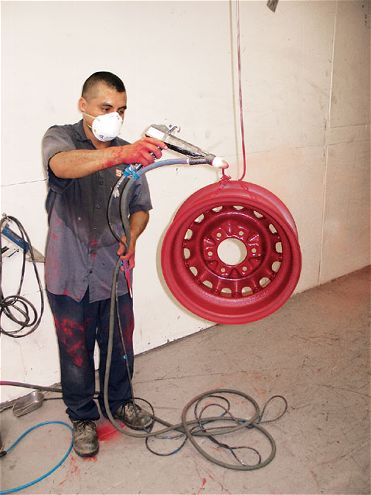

Though I recognize and affirmatively acknowledge the arguments for modern radial tires, with the exception of those that actually came with radials off the showroom floor, anything I own rolls on good old bias-plies. It may have something to do with my stubborn nature, but more importantly, I just don't think any cars or trucks from the 1950s on back look good with newer rubber beneath 'em, at least when they're mine. It's purely a style thing, and because of that, it requires that I accept the conditions under which the bias-plies will perform-not like radials. Now, when it comes to steel wheels, though, I tend to gravitate toward newer or repop ones, as dealing with old wheels that aren't even close to true is no fun at all. However, that's not always possible.
Recently, when I began looking for a certain style of wheel for my '53 Chevy-early 15-inch artillery type-I learned quite a few things. First and foremost, 15-inchers aren't as easy to come across as the narrower but larger-diameter 16s. Because of that, they fetch a much steeper price. (At the same time, OE-type 16-inch wheels can be had for a pretty good deal.) And due to a recent boom in popularity within the lowrider community, these wheels went from being relatively affordable to scarce collectibles overnight (the average price I encountered was $800 a set-unrestored). But there are still deals out there to be found, and I found some, but they were far from being in any condition to mount on my truck, so here began the restoration process.
Past experience has taught me that driving with bias-ply tires on today's highways can turn into a white-knuckle ride at higher rates of speed. Throw in a bent wheel or two and you might as well be wearing a kidney belt, as the bouncing never seems to stop. With this in mind, I made sure that my newly acquired wheels were as close to true as possible-if not, I'd have to get them straightened before proceeding. Fortunately, the worst damage found was a flat spot or two on the outer lip of one of the wheels. It appeared I was up for a complete cosmetic redo, so I loaded the four wheels up and headed down to Surf City-Huntington Beach, where Specialized Coatings is located.
Rather than treating the wheels like a typical exterior component and having them bodyworked and painted, I opted to go the powdercoat route. Since I figured they'd be on and off the truck quite a bit in the near future, I wanted a durable surface that would hold up to the constant abuse of lug wrenches, hubcaps, tools, etc.-something paint can't easily do. And unlike the olden days where color choices and finishes were limited, today's powdercoats come in everything from metallics to woodgrain and even anodized looking, so I wasn't limited to basic red or black. Furthermore, Specialized assured me that their skilled technicians could make a Stone Age wheel look new again.
So my wheel woes were cured, but I still had to round up some rubber and a new set of hubcaps. For the whitewalls, I went to my one and only source for vintage bias-plies: Coker Tire. Normally, I would have gone with a standard 670-15, but since I wanted to accentuate the lowered suspension, not raise it, I chose to run their 640-15 B.F.Goodrich Silvertowns, which are more than half an inch smaller in diameter and don't have the classic "pie crust" edge, which I didn't want for this application. The 640s have a leaner, cleaner look, which is exactly what I was after. For the 'caps, I simply stopped by Brothers on my way home from work one afternoon and grabbed a set of stainless beauties that for all intents and purposes are exact replicas of the originals.
While my truck still has quite a ways to go before I can call her done, she's sure a lot more easygoing on the road-and the eyes, as well-with her new pair of shoes!